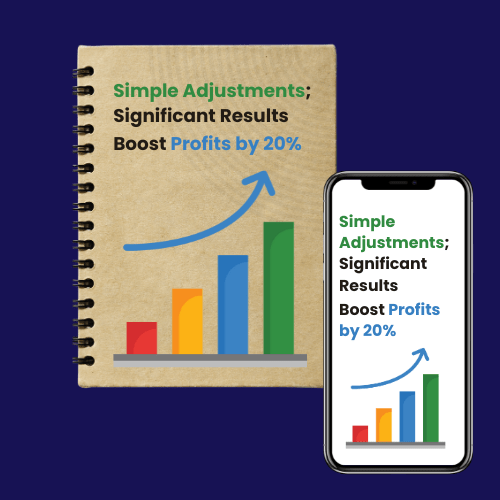Introduction
Imagine you own a cozy little bookstore, a haven for book lovers who spend hours browsing through shelves, sipping coffee, and enjoying the peaceful ambiance. Every day, sales seem to be steady—customers buy books, chat about their favorites, and leave with smiles. But when you sit down at the end of the month to analyze your finances, something doesn’t add up. Your revenue isn’t matching your foot traffic, and profits are nowhere near what you expected. Where is your money going?
The truth is, hidden revenue leaks may be quietly eating away at your profits, just like termites in an old bookshelf. These leaks don’t make a loud noise, but over time, they accumulate into massive financial losses. The good news? You can find and fix them—if you know where to look. Let’s uncover these sneaky drains and seal them for good.
The Reality of Revenue Leaks
Many business owners believe that as long as they are making sales, their business is profitable. But that’s far from the truth. If money is slipping through the cracks unnoticed, your sales efforts can be in vain. A missing invoice here, a forgotten contract renewal there—these small, seemingly insignificant errors can cost you thousands without you realizing it.
Think of it like a leaky bucket: no matter how much water (revenue) you pour in, if there are holes, it will never fill up. Identifying and fixing these leaks is essential to ensuring that every dollar you earn stays where it belongs—inside your business.
Identifying Revenue Leaks
1. Unbilled or Late Invoicing: The Case of the Vanishing Sales
Imagine this: You host a delightful private book reading event for a group of literature enthusiasts. They have a fantastic time, leave raving reviews, and you feel proud of the experience you’ve created. But then, days pass, weeks pass… and you realize the invoice was never sent.
The result? The event was great, but you essentially worked for free.
Solution:
- Implement an automated invoicing system that immediately sends invoices after services are provided.
- Set payment reminders so no invoice is forgotten or delayed.
- Assign someone in your team to double-check outstanding invoices weekly.
2. Outdated Pricing Structures: Stuck in the Past
Think about inflation—when was the last time you adjusted your pricing? If your bookstore is still selling books at 2015 prices in 2024, you are losing money with every sale.
Let’s say you originally priced a book at $10 in 2015. If the cost of acquiring that book has increased to $12 today, but you are still selling it at $10, you are paying your customers to take your products. Not a great business model, right?
Solution:
- Conduct a quarterly pricing review to align with inflation and demand.
- Compare your pricing against competitors—are you undervaluing your products?
- Increase prices strategically—small increments over time won’t scare customers away, but will improve profitability.
3. Missed Contract Renewals: The Slipping Subscription
Your bookstore had an ongoing bulk order contract with a local school. They ordered books from you every semester like clockwork. But one semester, the order never came in. Confused, you reach out, only to hear, “Oh, we thought your contract had expired, so we found another vendor.”
Ouch. That’s recurring revenue lost, just because no one followed up.
Solution:
- Use a Customer Relationship Management (CRM) system to track contract renewals.
- Set automated renewal reminders 30-60 days before expiration.
- Proactively reach out to clients with exclusive renewal offers before they have a chance to look elsewhere.
4. Discount Overuse: The Self-Inflicted Wound
Many businesses fall into the trap of habitual discounting. You might think, “If I offer 20% off, I’ll attract more customers.” But if you overdo it, you end up training your customers to only buy when there’s a discount—and your margins suffer.
Let’s say you sell a book for $20, and you run frequent 30% off sales. That brings the price down to $14, which might barely cover costs.
Solution:
- Implement a smart discount strategy—reserve deep discounts for slow-moving inventory or limited-time promotions.
- Reward loyalty instead of price cuts—offer points, exclusive perks, or bonuses for repeat customers.
- Focus on value-driven promotions instead of outright discounts (e.g., “Buy two books, get a free bookmark!” instead of “30% off everything”).
How to Fix These Revenue Leaks
Fixing these leaks requires a mix of automation, strategy, and discipline. Here’s what you need to do right now:
✅ Automate Your Billing Process
- Invest in invoicing software like QuickBooks, FreshBooks, or Zoho Books.
- Set automatic reminders for overdue invoices.
✅ Regularly Review Pricing Structures
- Conduct a quarterly price audit to match industry standards and inflation.
- Experiment with value-based pricing rather than cost-plus pricing.
✅ Track Contract Renewals with a CRM System
- Set up automatic renewal reminders.
- Offer incentives for early renewals to keep clients locked in.
✅ Use Discounts Strategically
- Avoid excessive percentage-based discounts.
- Instead, bundle products, offer free shipping, or limited-time bonuses.
Small leaks sink big ships, and businesses are no different. Every missed invoice, outdated price, forgotten contract, or unnecessary discount can silently erode your profits. The key to long-term success isn’t just making more sales—it’s keeping more of what you earn.
So, take action today—audit your revenue leaks, implement these fixes, and watch as your profits grow without even needing extra sales!


